Can innovative environmental engineering solutions transform the way we handle waste in industries like hospitality?
The importance of effective waste management cannot be overstated, particularly in sectors where sustainable practices are becoming increasingly vital. As industries evolve, the need for expert waste management engineering becomes more pronounced.
Efficient waste management is crucial for minimizing environmental impact. By adopting cutting-edge techniques and strategies, industries can significantly reduce their ecological footprint.
Key Takeaways
- Effective waste management is critical for sustainable industrial practices.
- Environmental engineering plays a vital role in waste reduction.
- Innovative solutions can significantly minimize ecological impact.
- Sustainable waste management practices are increasingly important.
- Expert tips can help industries adopt more effective waste management strategies.
Understanding Waste Management Engineering
Waste management engineering is an interdisciplinary field that combines engineering principles with environmental science to develop sustainable waste solutions. It encompasses a broad range of practices and technologies aimed at minimizing waste and its environmental impact.
Definition and Importance
Waste management engineering is defined as the application of engineering principles to the design, operation, and management of systems that handle waste, from generation to disposal. The importance of this field lies in its potential to mitigate the environmental, health, and economic impacts associated with waste. As noted by experts, “Effective waste management is crucial for maintaining a healthy environment and conserving natural resources.” For more insights on sustainable practices, visit environmental engineering shaping a sustainable future.
The significance of waste management engineering is underscored by its role in reducing greenhouse gas emissions, protecting biodiversity, and promoting sustainable development. By adopting innovative waste treatment technologies and strategies, communities can minimize their environmental footprint.
Key Concepts in Waste Management
Several key concepts underpin the field of waste management engineering. These include:
- Waste reduction and minimization techniques
- Waste recycling and recovery methods
- Advanced waste treatment technologies
- Sustainable landfill design and operation
Understanding these concepts is essential for developing effective waste management strategies that are both environmentally sustainable and economically viable. As the field continues to evolve, the integration of new technologies and methodologies will be crucial in addressing the complex challenges associated with waste management.
“The future of waste management lies in our ability to adopt a circular economy approach, where waste is viewed as a resource rather than a problem.”
History of Waste Management Practices
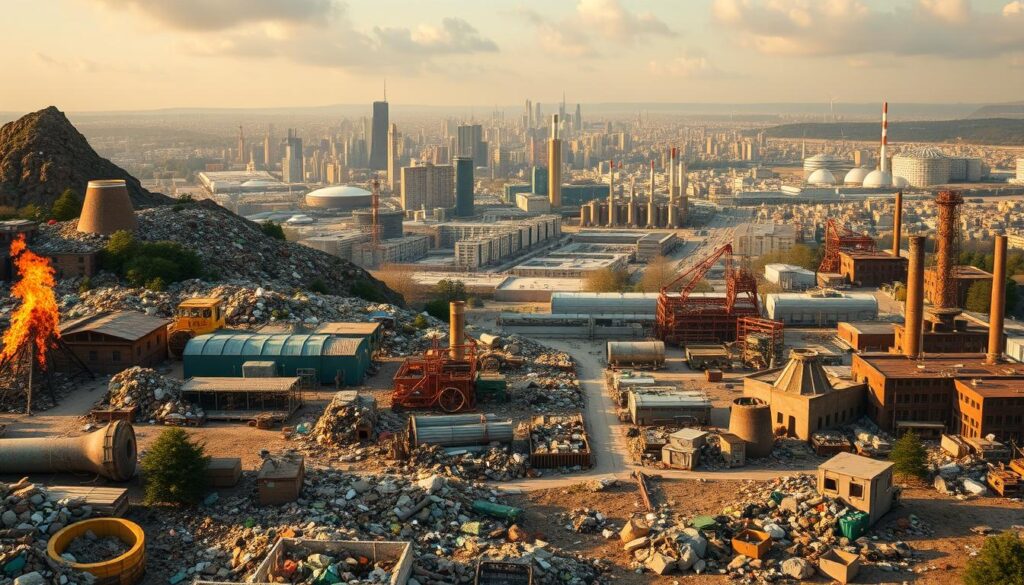
The development of waste management practices is closely tied to technological advancements and legislative changes. Over the years, societies have grappled with the challenges of waste disposal, leading to the evolution of complex systems and regulations.
Evolution of Waste Management Technologies
Waste management technologies have advanced significantly, from simple waste dumping to sophisticated waste disposal systems. Modern landfill management practices now incorporate environmental safeguards and technological innovations to minimize ecological impact.
The introduction of new technologies has transformed waste management. For instance, waste-to-energy facilities now play a crucial role in reducing landfill waste while generating energy. Similarly, advancements in recycling technologies have improved the efficiency of waste processing.
Milestones in Legislation
Legislation has played a pivotal role in shaping waste management practices. Key milestones include the enactment of laws regulating waste disposal, such as the Resource Conservation and Recovery Act (RCRA) in the United States, which has significantly influenced waste management engineering practices.
- The RCRA Act of 1976 provided a framework for managing hazardous and non-hazardous waste.
- The Comprehensive Environmental Response, Compensation, and Liability Act (CERCLA) of 1980 addressed the cleanup of hazardous waste sites.
- More recent legislation has focused on promoting recycling and reducing landfill waste.
These legislative milestones have not only driven the adoption of new technologies but also raised public awareness about the importance of effective waste management.
Types of Waste in Waste Management Engineering
Understanding the diverse types of waste is crucial for developing effective waste management strategies. Waste management engineering involves categorizing waste into distinct types, including solid, liquid, and hazardous waste, each requiring unique management approaches.
Solid Waste
Solid waste refers to non-liquid waste that is discarded or rejected as worthless or unwanted. It includes a wide range of materials, such as household trash, construction debris, and industrial waste. Effective management of solid waste is critical to prevent environmental pollution and protect public health.
For instance, the waste management process involves several steps, from collection to disposal, and sometimes includes recycling. The table below illustrates the different components of solid waste and their typical management strategies.
| Type of Solid Waste | Examples | Management Strategies |
|---|---|---|
| Household Waste | Food waste, packaging materials | Recycling, composting |
| Construction Debris | Concrete, wood, metal | Recycling, landfilling |
| Industrial Waste | Chemical waste, scrap materials | Specialized treatment, recycling |
Liquid Waste
Liquid waste, also known as wastewater, includes any liquid that is discarded or rejected as worthless or unwanted. It can originate from various sources, including industrial processes, agricultural runoff, and domestic sewage. The management of liquid waste is crucial to prevent water pollution and protect aquatic ecosystems.
Effective treatment of liquid waste often involves physical, chemical, and biological processes to remove contaminants. As noted by environmental experts, “Proper treatment of wastewater is essential to maintain water quality and support aquatic life.”
“The treatment and reuse of wastewater can significantly reduce the environmental impact of industrial activities.”
Hazardous Waste
Hazardous waste is waste that has substantial or potential threats to public health or the environment. It can be in the form of liquids, solids, gases, or sludges and can be generated from various sources, including industrial processes, household activities, and agricultural practices. The management of hazardous waste requires specialized techniques to minimize its environmental impact.
The proper disposal of hazardous waste is regulated by strict guidelines to prevent harm to humans and the environment. As stated in waste management regulations, “Hazardous waste must be handled, stored, and disposed of in accordance with specific guidelines to mitigate its risks.”
In conclusion, understanding the different types of waste is fundamental to effective waste management engineering. By categorizing waste into solid, liquid, and hazardous types, we can develop targeted strategies to manage each type effectively, reducing environmental pollution and promoting public health.
Waste Collection and Transportation Systems
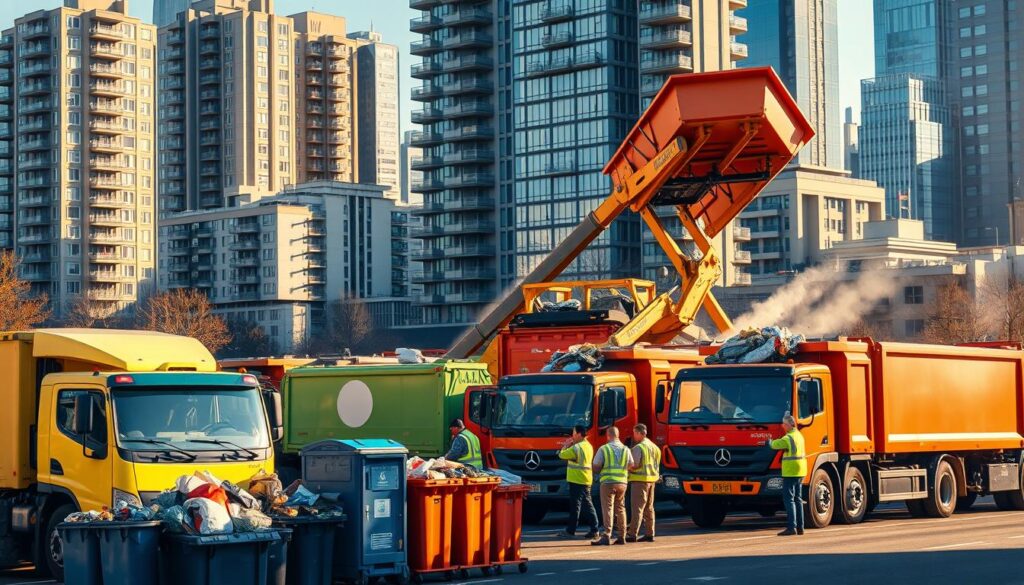
Waste collection and transportation systems play a vital role in maintaining public health and environmental sustainability. Effective waste management relies on the efficient movement of waste from its source to treatment or disposal facilities.
Collection Methods
Waste collection methods vary widely depending on the type of waste, local regulations, and available infrastructure. Common collection methods include curbside collection, communal collection points, and door-to-door collection.
Curbside collection is one of the most common methods used in residential areas. It involves residents placing their waste in designated bins, which are then collected by waste management services. For more information on curbside collection and other waste management practices, you can explore resources like Coursera’s course on solid waste collection.
Key Considerations for Collection Methods:
- Accessibility for waste collection vehicles
- Frequency of collection
- Type of waste being collected
- Community participation and education
Transportation Technologies
The transportation of waste from collection points to treatment or disposal facilities is a critical component of waste management. Various technologies are employed to optimize this process, including compactors, transfer stations, and specialized vehicles.
“The use of advanced technologies in waste transportation, such as GPS tracking and route optimization, can significantly reduce costs and environmental impacts.” – Waste Management Expert
| Transportation Technology | Description | Benefits |
|---|---|---|
| Compactors | Reduce waste volume | Lower transportation costs, increased efficiency |
| Transfer Stations | Facilitate the transfer of waste to larger vehicles | Improved logistics, reduced traffic congestion |
| Specialized Vehicles | Designed for specific types of waste | Enhanced safety, compliance with regulations |
Implementing efficient waste collection and transportation systems is crucial for effective waste management. By leveraging the right collection methods and transportation technologies, communities can reduce waste management costs and minimize environmental impacts.
Waste Processing and Treatment Methods
Advanced waste processing and treatment methods are essential for minimizing the environmental footprint of waste disposal. Effective waste management relies on various technologies and processes to reduce waste volume, recover resources, and mitigate environmental impacts.
Mechanical Processing
Mechanical processing involves the physical treatment of waste to change its size, composition, or characteristics. Techniques such as shredding, crushing, and sorting are used to prepare waste for recycling or further treatment. For instance, mechanical processing can be used to separate recyclable materials from mixed waste streams, enhancing the efficiency of waste recycling processes.
Biological Treatment
Biological treatment methods utilize microorganisms to break down organic waste. Processes such as composting and anaerobic digestion are effective for managing organic waste and producing valuable by-products like compost and biogas. Composting involves the aerobic decomposition of organic waste, resulting in a nutrient-rich soil amendment. Anaerobic digestion, on the other hand, produces biogas that can be used for energy generation, contributing to waste-to-energy conversion.
Thermal Treatment
Thermal treatment involves the use of high temperatures to treat waste, reducing its volume and potentially recovering energy. Incineration and gasification are common thermal treatment technologies. Incineration burns waste to produce heat or electricity, while gasification converts waste into syngas, which can be used as a fuel. These technologies are crucial for managing waste that is not suitable for recycling or biological treatment, and they play a significant role in waste treatment technologies.
In conclusion, a combination of mechanical, biological, and thermal treatment methods is necessary for effective waste management. By understanding and applying these technologies, communities can reduce waste volumes, recover resources, and minimize environmental impacts.
Recycling and Resource Recovery
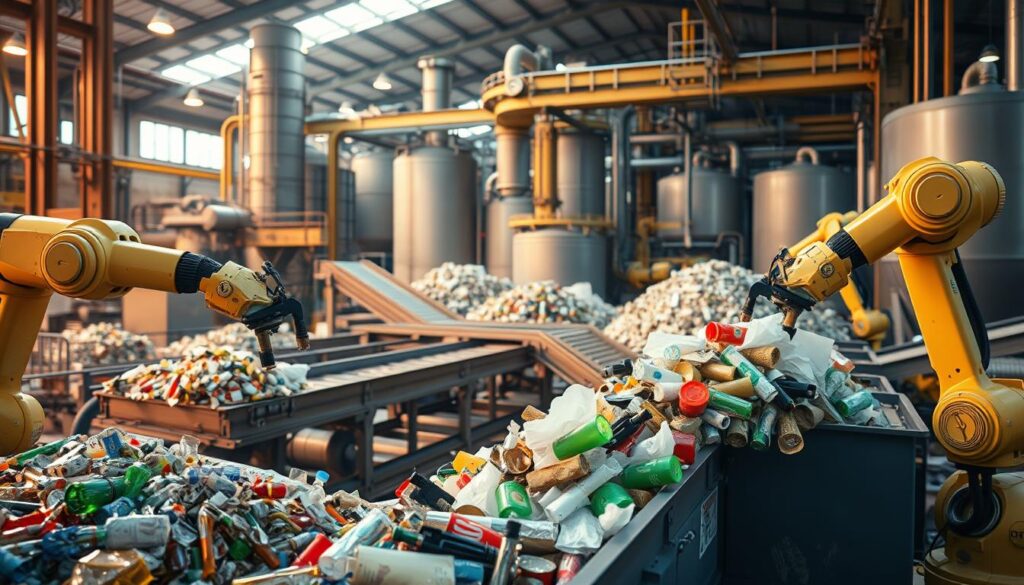
Recycling plays a pivotal role in waste management, offering a multitude of environmental and economic benefits. As the world moves towards more sustainable waste solutions, the importance of effective recycling practices cannot be overstated.
Benefits of Recycling
Recycling offers numerous benefits, including the conservation of natural resources, reduction in greenhouse gas emissions, and the creation of jobs. By reusing materials, we reduce the need for extracting, processing, and transporting raw materials, which in turn saves energy and water. According to the Environmental Protection Agency (EPA), recycling has a significant positive impact on the environment.
“Recycling is a critical component of modern waste management, providing substantial environmental and economic benefits.” –
The economic benefits of recycling are also noteworthy. It helps in saving communities money by reducing waste disposal costs and generating revenue through the sale of recyclable materials. Moreover, recycling supports the development of civil engineering projects focused on sustainable practices.
Sorting and Processing Techniques
Effective recycling relies on efficient sorting and processing techniques. Modern recycling facilities employ advanced technologies to sort materials based on their type, condition, and market demand. Common techniques include mechanical sorting, manual sorting, and the use of magnetic separators and eddy currents.
- Mechanical sorting uses machines to separate materials based on their physical properties.
- Manual sorting involves workers manually separating materials, often used in conjunction with mechanical sorting.
- Magnetic separators and eddy currents are used to separate ferrous and non-ferrous metals.
These techniques enhance the quality and quantity of materials recovered through recycling, contributing to a more circular economy. As recycling technologies continue to evolve, we can expect even more efficient resource recovery processes.
Landfill Design and Operation
Modern landfill practices have transformed the way we approach waste disposal, focusing on minimizing environmental impact. Landfills remain a necessary part of waste management infrastructure, and their design and operation are critical to ensuring they do not harm the environment.
Modern Landfill Practices
Modern landfills are engineered to prevent waste from contaminating the environment. This involves several key practices:
- Using liners to prevent leachate from seeping into groundwater
- Implementing leachate collection systems
- Capturing methane gas for energy production
- Designing landfills with caps to prevent erosion and minimize odors
These practices not only reduce the environmental impact but also make landfills more sustainable by recovering energy from waste.
Environmental Monitoring
Environmental monitoring is a crucial aspect of landfill operation. It involves regularly checking for signs of environmental contamination, such as groundwater pollution or methane emissions.
| Monitoring Parameter | Importance | Frequency |
|---|---|---|
| Groundwater Quality | Prevents contamination of drinking water sources | Quarterly |
| Methane Emissions | Reduces greenhouse gas emissions and explosion risks | Monthly |
| Leachate Levels | Ensures leachate collection system is functioning properly | Weekly |
By closely monitoring these parameters, landfill operators can take proactive measures to mitigate any adverse environmental impacts.
Hazardous Waste Management
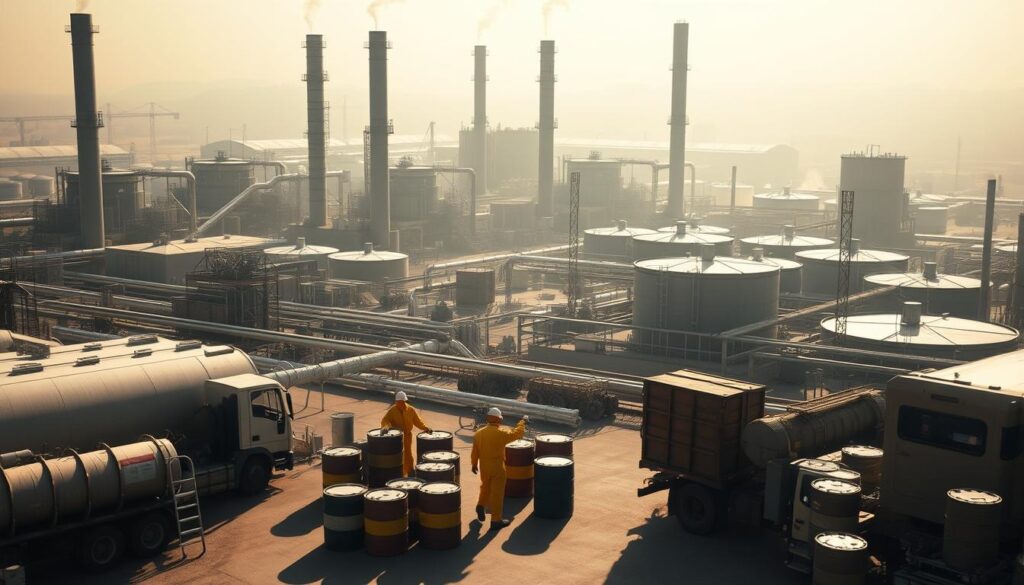
Hazardous waste poses significant challenges, requiring specialized management practices to ensure safe handling and disposal. Effective hazardous waste management is critical for protecting both human health and the environment from the potential dangers associated with hazardous materials.
Identification and Classification
The first step in managing hazardous waste is its identification and classification. This process involves determining the characteristics of the waste, such as its toxicity, corrosiveness, and reactivity. Accurate identification is crucial for selecting the appropriate treatment and disposal methods.
Key characteristics used in the classification include:
- Toxicity
- Corrosiveness
- Reactivity
- Ignitability
| Characteristic | Description | Example |
|---|---|---|
| Toxicity | The degree to which a substance is poisonous. | Chemical waste containing heavy metals. |
| Corrosiveness | The ability of a substance to cause destruction or deterioration of materials. | Acidic or alkaline waste. |
| Reactivity | The tendency of a substance to undergo a chemical reaction. | Explosives or substances that react violently with water. |
Treatment and Disposal Methods
Once hazardous waste is identified and classified, appropriate treatment and disposal methods must be selected. Treatment methods can include chemical, physical, or biological processes designed to reduce the waste’s hazardous characteristics.
Treatment and disposal options include:
- Incineration
- Chemical treatment
- Land disposal with appropriate containment measures
The choice of treatment and disposal method depends on the waste’s characteristics, regulatory requirements, and environmental considerations. Effective hazardous waste management requires a comprehensive approach that balances these factors to minimize environmental and health impacts.
Waste to Energy Technologies
As the world seeks more sustainable waste solutions, waste-to-energy technologies are emerging as a key player. Waste-to-energy conversion processes offer a promising avenue for reducing waste volume while generating energy. This approach not only mitigates the environmental impacts associated with traditional waste disposal methods but also contributes to the production of renewable energy.
Types of Waste to Energy Processes
There are several types of waste-to-energy processes, each with its unique benefits and applications. Some of the most common methods include:
- Incineration: This involves the combustion of waste materials at high temperatures to produce steam, which is then used to generate electricity.
- Anaerobic Digestion: A biological process where microorganisms break down organic waste in the absence of oxygen, producing biogas that can be used as a renewable energy source.
- Gasification: A process that converts waste into a synthesis gas (syngas) through high-temperature heating with a controlled amount of oxygen. The syngas can be used to generate electricity or heat.
- Pyrolysis: The thermal decomposition of waste materials in the absence of oxygen, resulting in the production of bio-oil, syngas, and char.
For a comprehensive understanding of various engineering courses that can lead to careers in waste management and energy production, visit Which Engineering Course is Best: A Comprehensive.
Benefits and Challenges
Waste-to-energy technologies offer several benefits, including:
- Reduction in waste volume sent to landfills.
- Generation of renewable energy.
- Potential for reducing greenhouse gas emissions compared to traditional fossil fuel-based energy production.
However, these technologies also face challenges such as:
- High initial investment costs.
- Potential environmental impacts, including air pollution if not properly managed.
- Public perception and acceptance issues.
Despite these challenges, waste-to-energy technologies are recognized as a crucial component of sustainable waste solutions. By understanding the different types of waste-to-energy processes and their benefits, communities can make informed decisions about implementing these technologies.
Sustainable Waste Management Strategies
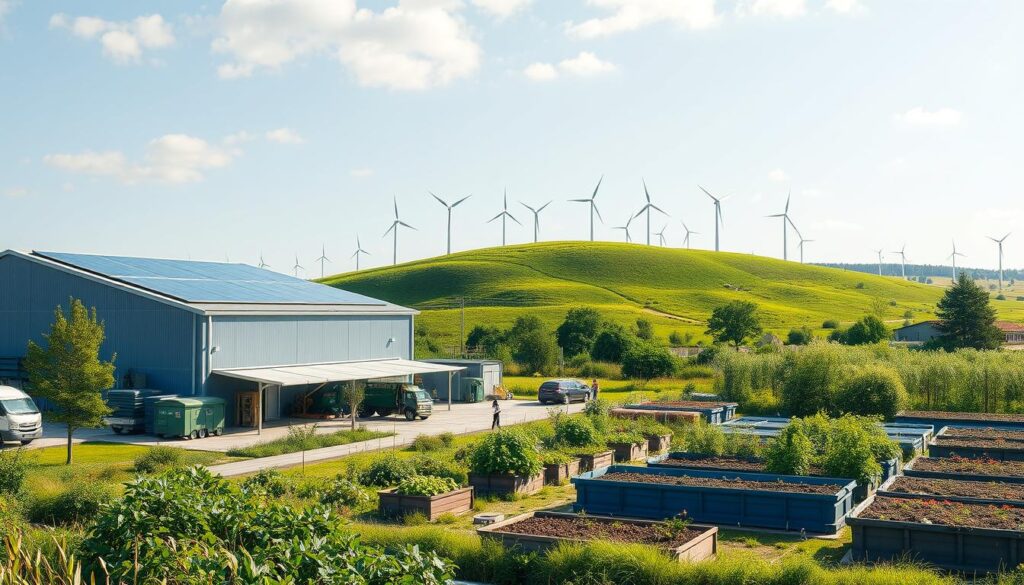
The need for sustainable waste management solutions has never been more pressing. As the world grapples with the challenges of waste disposal and environmental degradation, adopting sustainable waste management practices is crucial.
Integrating Circular Economy Principles is a key strategy in achieving sustainable waste management. A circular economy aims to reduce waste by promoting the reuse and recycling of materials. This approach can significantly reduce the environmental impacts associated with waste disposal.
Benefits of Circular Economy in Waste Management
- Reduction in waste sent to landfills
- Conservation of natural resources through recycling
- Lower greenhouse gas emissions
According to a report by the World Civil Society, integrating circular economy principles into waste management can lead to significant economic benefits, including cost savings and job creation.
Community Involvement and Education
Community involvement is vital for the success of sustainable waste management strategies. Educating the public about the importance of waste reduction and proper disposal practices can lead to significant improvements.
“Community participation is the backbone of any successful waste management program. By engaging with local communities, we can foster a culture of sustainability and environmental stewardship.” – Environmental Expert
Effective community involvement strategies include organizing waste reduction campaigns, implementing recycling programs, and providing education on sustainable practices.
| Strategy | Description | Impact |
|---|---|---|
| Waste Reduction Campaigns | Public awareness campaigns to reduce waste generation | Reduced waste sent to landfills |
| Recycling Programs | Implementation of recycling facilities and practices | Conservation of natural resources |
| Education on Sustainable Practices | Workshops and educational materials on sustainable living | Increased community engagement in sustainability efforts |
By integrating circular economy principles and fostering community involvement, we can develop effective sustainable waste management strategies that benefit both the environment and society.
Regulatory Framework for Waste Management
A robust regulatory framework is the backbone of successful waste management strategies. It encompasses a range of laws, regulations, and guidelines that dictate how waste should be managed, from collection to disposal.
The regulatory framework is crucial for ensuring that waste management practices are environmentally sustainable and safe for public health. It involves not just legislation but also the enforcement of these laws by government agencies.
Key Legislation in the United States
The United States has a comprehensive set of laws governing waste management. The Resource Conservation and Recovery Act (RCRA) is a cornerstone of federal hazardous waste management policy. It provides a framework for the proper management of hazardous waste, from generation to disposal.
Other significant legislation includes the Comprehensive Environmental Response, Compensation, and Liability Act (CERCLA), commonly known as Superfund, which addresses the cleanup of contaminated sites. For more detailed information on regulated waste management, visit the GSA Directives Library.
| Legislation | Purpose | Impact |
|---|---|---|
| RCRA | Regulates hazardous waste management | Ensures safe disposal of hazardous waste |
| CERCLA (Superfund) | Addresses contaminated site cleanup | Protects communities from hazardous waste sites |
Role of Government Agencies
Government agencies play a vital role in enforcing waste management regulations. The Environmental Protection Agency (EPA) is the primary federal agency responsible for enforcing federal environmental laws, including those related to waste management.
State and local agencies also have significant roles, as they often implement and enforce regulations that are tailored to their specific regions. This multi-layered approach ensures that waste management practices are adapted to local conditions while adhering to national standards.
The regulatory framework for waste management is complex and multifaceted, involving various laws and government agencies. Understanding this framework is essential for effective waste management engineering.
Innovations in Waste Management Engineering

Innovations in waste management engineering are transforming the way we handle waste, making processes more efficient and sustainable. The integration of technology and engineering principles is leading to significant advancements in the field.
Smart Waste Solutions
Smart waste solutions are at the forefront of waste management innovation. These solutions utilize advanced technologies such as IoT sensors, data analytics, and automation to optimize waste collection and disposal processes. For instance, smart bins equipped with sensors can monitor waste levels and notify waste management teams when they need to be emptied, reducing unnecessary collections and improving route optimization.
According to a report, “The adoption of smart waste management solutions can lead to a significant reduction in operational costs and environmental impact.”
“Smart waste management is not just about technology; it’s about creating a more efficient, sustainable, and responsive waste management system.”
Emerging Technologies
Emerging technologies are playing a crucial role in shaping the future of waste management. Technologies such as artificial intelligence (AI), blockchain, and advanced recycling technologies are being explored for their potential to revolutionize waste management practices. For example, AI can be used to predict waste generation patterns, while blockchain can enhance transparency in waste management processes.
As highlighted in Discover Engineering, “Innovations in waste management technology are not only improving efficiency but also reducing the environmental footprint of waste disposal.”
The future of waste management engineering looks promising, with continued advancements in smart waste solutions and emerging technologies. As the industry continues to evolve, it is likely that we will see even more innovative solutions that address the complex challenges of waste management.
The Future of Waste Management Engineering
The waste management industry is on the cusp of a revolution, driven by innovative technologies and a growing focus on sustainability. As the global population continues to grow, the need for effective waste management solutions will become increasingly important.
Emerging Trends
Future trends in waste management engineering include the adoption of smart waste solutions, such as the Pello system, which monitors the fill-level of trash cans and provides real-time information on the dumpsters’ contents and location. Additionally, AI robots are being used in recycling centers to quickly and accurately differentiate between different materials.
Sustainable Practices
Sustainable waste solutions, such as pneumatic waste pipes and solar-powered trash compactors, are becoming increasingly popular. These technologies can significantly reduce the environmental impact of waste management by minimizing the need for garbage trucks and increasing the capacity of traditional trash bins.
As the industry continues to evolve, it is clear that sustainable practices will play a crucial role in shaping the future of waste management engineering. By adopting innovative technologies and promoting a circular economy, we can create a more sustainable future for generations to come.
